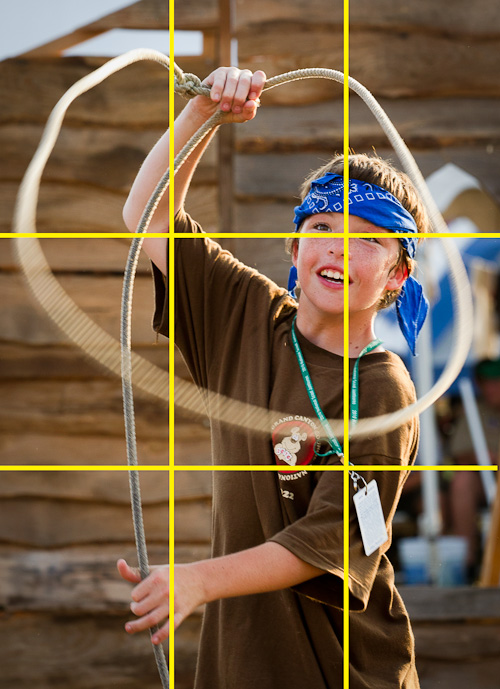Rule of Thirds

Life Scout Steven Neel, 13, from Mesa, Ariz., practices his roping on the Troop 2022 gateway at the 2010 National Scout Jamboree at Fort A.P. Hill, Virginia, Thursday July 29, 2010. Photo by Mark Duncan
The so-called Rule of Thirds is probably the most used compositional technique by professional photographs. It is simple to learn and simple to apply. This technique alone will make others who don’t know the technique think your pictures are good.
Imagine dividing the frame both horizontally and vertically into thirds. It doesn’t have to be exact. Now place a dominate feature in one or more of the intersections. In this example by Mark Duncan, Steven’s head in the upper right intersection. This technique works no matter whether you are composing a horizontal or vertical picture. Since you are dividing the frame into thirds in both directions, it doesn’t matter how you hold the camera.
What is this technique really doing? It is getting your subject out of the center of the frame for a more asymmetrical composition. For most subject matter, this usually improves the photograph in comparison to putting the subject dead center. Centering subjects is the usual technique that amateurs use.
This technique is used so often it is commonly called the “Rule of Thirds.” That said, rules are sometimes broken for good effect. There are some good reasons to place the subject dead center in the frame. The usual situation is when the subject has a natural symmetry. Other subjects might be surrounded by circles or tubes and might look better centered.
Let the subject dictate the composition. Realize the Rule of Thirds is easy to apply and often works well.
In this example picture Steven is to the right of frame, which leaves room for his arm to swing the rope toward the left side of the frame.
You can also use the Rule of Thirds to place the horizon line in your picture. Suppose you are at a seaside and you are photographing a sailboat. There are some beautiful cloud formations. You might want to place the horizon line where the sky meets the ocean on the lower 1/3 line. You would place the sailboat on one of the lower intersections with the vertical 1/3 lines, allowing the boat to point into the open space on the other side of the frame.
Play with this technique and learn it well. You will use it frequently.
